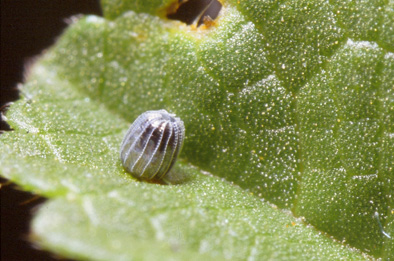 © Peter J. Bryant. |
Painted Lady Vanessa cardui Lepidoptera: Nymphalidae Back to Butterflies of Orange County, California |
|
Big Canyon, Newport Beach, Orange County, CA. 9-16-06. © Ron Hemberger |
 Thomas E. Riley Wilderness Park, Coto de Caza, Orange County, CA. 10-09-08. © Ron Hemberger |
 Thomas E. Riley Wilderness Park, Coto de Caza, Orange County, CA. 10-09-08. © Ron Hemberger |
 Thomas E. Riley Wilderness Park, Coto de Caza, Orange County, CA. 10-09-08. © Ron Hemberger |
 Still flying! Thomas E. Riley Wilderness Park, Coto de Caza, Orange County, CA. 11-08-08. © Ron Hemberger |
Freshly laid egg. © Peter J. Bryant. |
Egg ready to hatch. © Peter J. Bryant. |
Larva with silk web. © Peter J. Bryant. |
Larva with silk web accumulating frass. © Peter J. Bryant. |
Later larva, out of web. © Peter J. Bryant. |
Last instar larva. © Peter J. Bryant. |
Prepupa. © Peter J. Bryant. |
Pupa. © Peter J. Bryant. |
Similar Species: Vanessa annabella (West Coast Lady) and to a lesser extent Vanessa virginiensis (the Painted Beauty or Virginia Lady). See remarks under these species for distinguishing characteristics. Habitats, Behavior: Found in almost any sunny and open spot during years of abundance. Distribution: Probably the world's most widely distributed butterfly, the Painted Lady is often a common sight in Orange County, although in some years it is almost absent. Usually seen at lower elevations, it occurs at all elevations in the county during years of migration. Flight Period: Orange County records extend from January to October, although the species conceivably may be found throughout the year. Multiple brooded. Larval Foodplants: Cheeseweed, (Malva spp.); thistles, Cirsium spp.; Dwarf Nettle (Urtica urens); lupine, Lupinus spp.; fiddleneck (Amsinckia spp.) and many other plants, particularly those belonging to the large plant family Asteraceae. The larvae, when present in large numbers, have also have been known to cause local damage to beans, artichokes and mint (Cooperative Economic Insect Report 23 (21): 307, 1973). The Nasco Home School Internet Catalog offers a Butterfly Garden Kit for the rearing of painted lady butterflies. Migration: Painted Lady butterflies are often seen migrating northward through Orange County (and elsewhere in the western Other well-documented migrations: April 15-29, 2001 These migrations are triggered at least partly from heavy winter rains in the desert. Dr. Vernon Stern (U. C. Riverside; personal communication) has found that the migrations originate in From Orsak, L. J. (1977). The Butterflies of Orange County, California. Center for Pathobiology Miscellaneous Publication #3. University of California Press, New York. 349pp. The Red Admiral and Painted Lady Web site Return to Butterflies and their larval foodplants |
|









